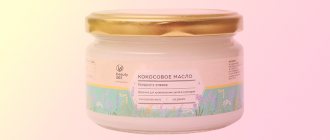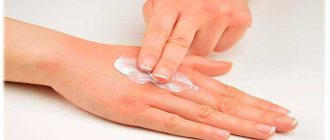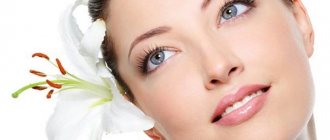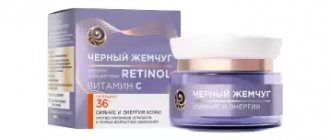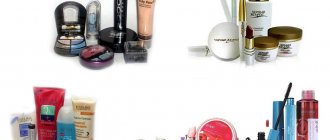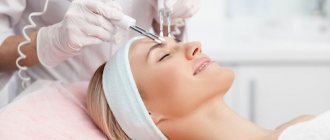Updated: 05/25/2021 18:43:59
Expert: Arefieva Elizaveta Aleksandrovna
Problem skin is considered to be oily epidermis with enlarged pores. However, this is only partly true. In fact, even combination and dry skin can be uncomfortable and require special care. In particular, we are talking about the thin, depleted epidermis on the face.
To fix the problem, you need to study it in as much detail as possible. This will help you properly organize the care process and choose the best options for cosmetics.
Photo: dryskintips.org/
Pros and cons of thin skin on the face
The main reasons for thinning skin are age-related changes, unfavorable heredity and dehydration. And if it is impossible to get rid of the first two provoking factors, then the loss of moisture from the epidermal cells can be eliminated.
The main disadvantages of thin leather are:
- high sensitivity to external factors;
- pallor resulting from a lack of melanin;
- tendency to rapid loss of elasticity due to a lack of fat in their thickness;
- with an incorrect lifestyle, the owner of a thin epidermis may notice the appearance of hyperemia or swelling on the surface of the face;
- tendency to peeling and irritation;
- a feeling of tightness after washing.
In its structure, the thin skin of the face is as close as possible to the epidermis around the eyes, so care for these areas is the same. Therefore, you can use the same cosmetics.
Surprisingly, thin facial epidermis has some advantages
. It is not prone to acne and oily sheen; there are no blackheads or areas with enlarged pores on its surface. However, this is not a reason to refuse careful care of thin skin.
What processes occur in the skin when it loses elasticity?
Young skin is elastic and elastic. It does not deform under mechanical influence. If you squeeze or stretch it, it will retain its structure without damage (elasticity) and quickly return to its original shape (elasticity).
Why does this happen?
The dermis, its supporting layer, which is located between the epidermis and subcutaneous fat, is responsible for the firmness, elasticity, and strength of the skin. The dermis is a connective tissue that consists of collagen, elastin and hyaluronic acid.
These substances are the main components of youthful skin. Collagen and elastin are proteins that form a natural framework in the form of intertwined fibers. Hyaluronic acid creates a moist environment for them.
- Collagen fibers
work like the spring frame of a mattress: they return the tissue to its original shape after compression. - Elastin fibers
run diagonally at different angles and thus hold the dermis together, keeping its components from separating. - Hyaluronic acid
provides skin hydration, which is also necessary for smoothness and elasticity. It helps moisture retain in the skin in the form of a kind of gel. One molecule of hyaluronic acid is capable of attracting and holding up to 10 molecules of water in the intercellular space so that it does not all come out (through the pores of the skin we lose up to half a liter of liquid per day). In addition, hyaluronic acid protects against toxins.
But over the years, the structure of the dermis is disrupted. What leads to this?
- Blood circulation slows down,
the delivery of oxygen and nutrients to skin cells deteriorates, and their metabolism is disrupted. - Lymphatic circulation suffers,
excess fluid accumulates in the tissues of the face, it swells, and the skin becomes loose. - At some point, a hormonal factor comes into play:
the level of estrogen – “beauty hormones” – decreases. The number of fibroblasts - cells that participate in the synthesis of collagen, elastin and hyaluronic acid - directly depends on them.
All this is reflected on the skin:
- In the dermis, the renewal of collagen, elastin, and hyaluronic acid worsens (due to a reduction in the number of fibroblasts).
The quality of available fibers deteriorates. Elastin becomes fragile and breaks, collagen loses its properties.Result: the skin loses firmness, elasticity, strength, ability to retain moisture, and becomes defenseless against toxins.
- In addition to hyaluronic acid, the hydro-lipid mantle is responsible for skin moisture and its protection from the environment.
This is a film that covers the top layer of skin. It consists of the products of the activity of the sebaceous and sweat glands (located in the dermis). Over the years, this water-fat layer becomes thinner as the activity of the glands decreases. Result: dryness and dehydration. - Changes also occur in the deepest layer of the skin - subcutaneous fat (hypodermis).
It becomes thinner, while the area of the skin remains the same, that is, part of the integument turns out to be “extra.” Result: sagging skin. - In addition, the dermis is penetrated by blood and lymphatic vessels, nerve endings, sebaceous and sweat glands. The deterioration of their condition also affects the loss of skin elasticity.
Features of thin facial skin
The thinned facial epidermis has its own characteristics that are characteristic only of it. They need to be known and taken into account in order to ensure proper care of problem areas. Main features of thin skin:
- absence of unnatural shine and greasy film;
- velvety and matte;
- absolutely smooth surface without areas with enlarged pores;
- tightness, excessive dryness and tendency to frequent peeling;
- frequent hyperemia due to capillaries located close to the surface of the epidermis;
- pallor;
- tendency to develop bruises under the eyes due to prominent veins.
Thin skin is easily irritated when exposed to negative external factors. They can be either cigarette smoke and cold air, or heat, and even the purchase of new cosmetics.
How to apply masks correctly?
We've sorted out the mask recipes. But for them to really “work”, you need to know 11 rules for applying a mask:
- Prepare your skin before the procedure. Cleanse your face with foam or gel, even if you didn’t do makeup today.
- Steam your face so that the components penetrate into the deep layers of the epidermis. Keep a terry towel under steam or wet it with hot water and apply it to your face for a few minutes. Simply washing with hot water will not work. It will irritate the skin rather than open the pores.
Use a scrub . It will remove dead skin particles from the skin, and it will become more susceptible to the action of masks.
- Be sure to make sure you are not allergic to the ingredients by testing the mask on your elbow.
- Do any treatment 2 hours before bedtime so that all the ingredients have time to be absorbed and you do not experience swelling.
- It is most convenient to apply the mask with your fingers, but you can also use a flat silicone brush . The main rule is that the brush should be dry and clean.
- Put on a mask - relax . Sit comfortably on the sofa, turn on some calm music and dream. Can you afford to rest for 15 minutes! If you run around the house in a fuss at this time, the mask will slip or smear, and you will not notice the effect.
- Do not keep the mask on your face for longer than prescribed . Clay that has dried on the skin will dry it out excessively, cleansing masks can erase the protective layer, and nourishing masks will cause irritation if overexposed.
- Rinse off the mask with water at room temperature.
- Immediately apply a cream suitable for your skin type .
- And the most important. Take care of your face regularly , not by inspiration.
Factors that harm thin facial skin
Photo: self.com/
No amount of care, even the most correct and thorough, can improve the condition of the thin epidermis unless the influence of certain negative factors on it is excluded. Most of all, problematic skin is harmed by:
- excess ultraviolet radiation;
- windy and frosty weather;
- temperature changes;
- hard tap water;
- incorrectly selected or low-quality cosmetics.
Unfortunately, some people with thin skin will have to give up excessive facial activity. This applies primarily to emotional individuals. With this nature, facial wrinkles may appear on the thinned facial epidermis by the age of 30.
Whitening homemade face masks
Don't like freckles and age spots? If you forget about sunscreen, and even in winter you get an uneven tan? There are two ways to restore a beautiful complexion and smooth skin: take a whitening course from a cosmetologist or use natural home remedies.
Whitening face masks at home should be done carefully and be sure to test on a small area of skin. The thing is that whitening masks contain “aggressive” components that can cause irritation or allergies.
Whitening mask with lemon
Action : evens out complexion, nourishes, whitens, eliminates age spots and freckles, accelerates metabolic processes in cells.
Apply the mask once a week for a month, and your face will acquire an even color.
You will need:
- 1 tablespoon oatmeal;
- 1 teaspoon milk;
- 1 teaspoon honey;
- 1.5 teaspoons lemon juice;
- 1 egg white.
Cooking method:
- Grind oatmeal into flour.
- Beat the egg whites until a thick foam forms.
- Mix all ingredients.
- Apply the mask to your skin for 20 minutes.
- Rinse off with warm water.
Whitening mask with parsley juice
Action: parsley has long been considered the best remover of pigmentation; in addition, the plant perfectly saturates the skin with vitamins. Cucumber has a tonic, calming and refreshing effect. Sour cream makes the skin elastic, toned and velvety, and lemon juice will not only enhance the whitening effect, but also get rid of pimples.
Ingredients:
- 1 tablespoon cucumber pulp;
- 1 teaspoon of fat sour cream;
- ½ teaspoon lemon juice;
- 1 teaspoon chopped parsley.
Cooking method:
- Stir in cucumber, sour cream, lemon juice and parsley.
- Apply the mask to a clean face for 20 minutes.
- Rinse off with warm water.
wipe your face with parsley decoction every day ; after a few uses, your face and age spots will become a tone lighter.
The recipe is simple : pour boiling water over chopped parsley leaves and leave to brew for 30 minutes. Then dip a cotton pad in the broth and wipe your face.
General principles of care for thin skin
Dermatologists and cosmetologists emphasize that without proper care, thin facial skin will begin to intensively lose moisture, which it already lacks. Because of this, it will become even thinner, wrinkles will form on its surface, and it will become inflamed even with minor influences from the external environment.
To avoid unwanted consequences, you must follow these principles of care:
- use high quality cosmetics designed for sensitive skin;
- To remove makeup, use only special products, but in no case tap liquid;
- wash only with cosmetic milk or gentle gel, stopping the use of soap, which disrupts the pH of the skin and has drying and antibacterial properties;
- do not leave decorative cosmetics on your face all night;
- use day and night moisturizing and nourishing cream for very dry skin;
- once every 10 days you can use gommage, but not scrub or peeling;
- after 30 years, turn to the use of anti-aging skincare cosmetics;
- before going outside, apply sunscreen to your face;
- several times a week, make homemade face masks that have moisturizing and nourishing properties and do not contain alcohol or aggressive substances;
- for washing, use soft, cool, but not hot water, which must first be filtered;
- exclude the use of cosmetic ice and herbal infusions or decoctions;
- remove from the menu all foods that cause any negative changes in the skin of the face;
- limit the time spent in conditions of elevated temperatures;
- do not conduct aromatherapy sessions, especially using new or unknown oils or mixtures.
It is recommended to undergo a course of vitamin therapy annually. The complexes should contain ascorbic acid, retinol, tocopherol and cobalamin (vitamin B12).
Useful tips
In fact, the most important thing thin skin needs is sealing. To achieve this effect, you can:
- combine salon and home care;
- try to spend less time in the sun and use cosmetics with a high SPF level;
- Healthy food;
- Avoid staying in saunas, steam baths and generally steaming the skin.
Thin skin requires regular care, gentle handling and following simple recommendations.
To avoid problems with the dermis for as long as possible, you should set aside time daily for useful procedures and use only products approved for this skin type.
Rules for choosing cosmetics for thin skin: what is in the composition?
Proper care of problematic epidermis is impossible without the use of special cosmetics. But it is also necessary to select it taking into account certain rules, based on information about the composition. It must contain the following components:
- allantoin: relieves inflammation and irritation, accelerates the healing of wounds and cracks;
- hyaluronic acid: has moisturizing properties, improves the ability of skin cells to regenerate;
- vegetable oils (almond, jojoba, myrrh, etc.): moisturize, nourish, create a protective film on the surface of the skin;
- retinol: moisturizes, relieves irritation, inflammation, peeling, heals small cracks and wounds;
- ascorbic acid: stimulates collagen production, strengthens local immunity, makes capillary walls stronger;
- tocopherol: has antioxidant properties, rejuvenates, moisturizes.
Additionally, the composition of care products may include extracts of medicinal plants. They may have anti-inflammatory, soothing, regenerating and many other beneficial properties.
Homemade masks for dry skin
Winter is the driest season for your skin, and if your skin is naturally dry, it needs special care. Wind, cold and heat from the battery damage the epidermis and dry it out, and poor nutrition and stress lead to peeling, a feeling of tightness and the appearance of wrinkles. Homemade moisturizing and nourishing masks will come to the rescue. They will not only preserve the youth of the skin, but also restore its protective properties.
Moisturizing mask for dry skin
Action: honey nourishes, smoothes wrinkles, enhances cell renewal. Sour cream has a powerful moisturizing effect, tightens the skin and makes it elastic and firm. Oatmeal contains a huge amount of microelements that saturate skin cells with moisture, smooth and eliminate dryness.
Ingredients:
- 1 tablespoon oatmeal;
- 1 teaspoon honey;
- 1 teaspoon of fat sour cream.
Cooking method:
- Grind oatmeal into flour;
- Add honey and sour cream;
- Apply to steamed and cleansed facial skin for 20 minutes;
- Rinse off the mask with water.
Aloe mask for dry skin
Action: Aloe is a plant that has had to work hard to survive in a hot climate. That is why it contains a storehouse of vitamins. Aloe juice penetrates deeply into the epidermis, soothes, nourishes, regenerates, refreshes and moisturizes the skin, smoothing out wrinkles.
You will need:
- 1 tablespoon aloe gel;
- 1 teaspoon olive oil;
- 1 teaspoon honey.
Preparation:
- Cut off the bottom leaf of the aloe.
- Remove the green peel from one side of the leaf with a knife.
- Use a teaspoon to collect the gel (it is better to use it the same day).
- Mix honey, gel and oil.
- Apply to facial skin for 20 minutes.
- Rinse off the mask with warm water.
I asked the main aloe fan in my circle to test this mask - my grandmother. She said that immediately after rinsing off, she felt smooth and soft skin. The mask does not tighten it, but moisturizes it, maintaining the effect for a long time.
